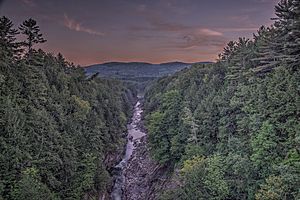Quechee Gorge facts for kids
The Quechee Gorge is a truly amazing natural wonder located in Quechee, Vermont. You can find it right along U.S. Route 4. This gorge is super deep, reaching about 165 feet down! That makes it the deepest gorge in all of Vermont. It's a really popular spot for tourists and is part of Quechee State Park. You can get great views from the U.S. Route 4 bridge or from walking trails on both sides. Many people from all over New England come to see its beauty. The Ottauquechee River flows through the very bottom of the gorge. It's a favorite place for whitewater kayaking.
Contents
What is Quechee Gorge?
Quechee Gorge is often called "Vermont's Little Grand Canyon." It's a huge, narrow valley carved by a river over thousands of years. The gorge is a fantastic place to visit. You can stand on the bridge and look straight down into the deep canyon. There are also trails where you can hike and explore. These trails offer different views of the gorge and the river below. It's a perfect spot for nature lovers and adventurers.
Exploring the Gorge
When you visit Quechee Gorge, there are many things to do. You can walk across the U.S. Route 4 bridge. From here, you get a breathtaking view of the gorge's depth. There are also hiking trails on both sides of the gorge. These trails let you get closer to the river. You can even walk down to the water's edge in some spots. The Ottauquechee River is popular for kayaking. People enjoy the exciting whitewater rapids. It's a great place to see Vermont's natural beauty up close.
How Quechee Gorge Was Formed
The story of Quechee Gorge began about 13,000 years ago. At that time, a giant sheet of ice covered much of North America. This huge ice sheet was called the Laurentide Ice Sheet. As the climate warmed, this massive glacier slowly started to melt and move away.
The Power of Ice and Water
When the glacier retreated, it left behind a huge lake. This ancient lake was known as Lake Hitchcock. The Ottauquechee River flowed into this lake. As the glacier melted, a lot of water was released. This water caused Lake Hitchcock to drain very quickly. The fast-moving Ottauquechee River then started to cut deeply into the bedrock. This rapid cutting action carved out the deep gorge we see today. The gorge cuts through a type of rock called the Devonian Gile Mountain Formation. You can also see darker rock formations, called Mesozoic mafic dikes, on the west wall. These show different stages of the Earth's history.



